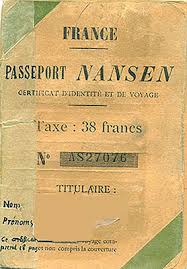
Between 1914 and 1922, Europe was shaken by World War I, the Russian Revolution and the Ottoman Empire’s genocide of Armenians. Millions of people were displaced, sparking a huge refugee crisis.
An idealistic Norwegian called Fridtjof Nansen (1861-1930) came to their rescue. Nansen was a renowned polar explorer and scientist who later became a diplomat and a leading light of the League of Nations formed at the end of World War I.
In 1921, Vladimir Lenin took away Russian citizenship from the 800,000 expatriates who had fled during the Revolution. Other countries refused to accept the asylum-seekers. Put in charge of solving the crisis, Nansen’s first action was to repatriate the refugees, but they were either executed, imprisioned or forbidden from re-entering by the Soviet government.
In March 1922, Nansen proposed a temporary passport. The Nansen passport featured the holders’ identity, nationality and race and allowed them to move between countries to find jobs and missing family members. ‘Nansen stamps’ had to be bought to renew the passport every year (the money went to refugee relief funds).
Eventually, 52 governments recognised the Nansen passport.
Nansen received the Nobel Peace Prize in 1922. By 1938, around 450,000 refugees, including writer Vladimir Nabokov, composer lgor Stravinksy and ballerina Anna Pavlova, had been rescued from a bleak future by the Nansen passport.
Nansen’s noteworthy achievements
Norwegian explorer Fridtjof Nansen led the team that made the first crossing of the Greenland interior in 1888, traversing the island on cross-country skis. He won international fame after reaching a record northern latitude of ’ during his Fram expedition of 1893-1896.
As a curator at the University Museum of Bergen where his research on the central nervous system of lower marine creatures earned him a doctorate.
After 1896 his main scientific interest switched to oceanography; in the course of his research he made many scientific cruises, mainly in the North Atlantic, and contributed to the development of modern oceanographic equipment.
Later, Nansen devoted himself primarily to the League of Nations, following his appointment in 1921 as the League’s High Commissioner for Refugees. In 1922 he was awarded the Nobel Peace Prize for his work on behalf of the displaced victims of the First World War and related conflicts.
Picture Credit : Google



